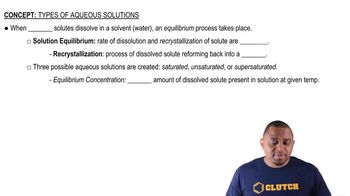Here are the essential concepts you must grasp in order to answer the question correctly.
Solubility Product Constant (Ksp)
The solubility product constant (Ksp) is an equilibrium constant that applies to the solubility of sparingly soluble ionic compounds. It is defined as the product of the molar concentrations of the ions, each raised to the power of their coefficients in the balanced equation. For PbI2, Ksp = [Pb2+][I-]^2, which allows us to calculate the solubility of the compound in a saturated solution.
Recommended video:
Solubility Product Constant
Saturated Solution
A saturated solution is a solution that contains the maximum concentration of a solute that can dissolve at a given temperature and pressure. In a saturated solution of PbI2, the concentrations of Pb2+ and I- ions remain constant, as the rate of dissolution of the solid equals the rate of precipitation. Understanding this concept is crucial for calculating Ksp and determining ion concentrations in various scenarios.
Recommended video:
Types of Aqueous Solutions
Stoichiometry of Dissolution
The stoichiometry of dissolution refers to the ratio of ions produced when a compound dissolves in water. For PbI2, the dissolution can be represented as PbI2(s) ⇌ Pb2+(aq) + 2I-(aq). This means that for every mole of PbI2 that dissolves, one mole of Pb2+ and two moles of I- are produced. This stoichiometric relationship is essential for calculating the concentrations of ions in saturated solutions based on the known concentration of one ion.
Recommended video:
 Verified step by step guidance
Verified step by step guidance

